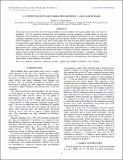| dc.contributor.author | Schlaufman, Kevin C | |
| dc.date.accessioned | 2015-04-22T18:50:58Z | |
| dc.date.available | 2015-04-22T18:50:58Z | |
| dc.date.issued | 2015-01 | |
| dc.date.submitted | 2014-11 | |
| dc.identifier.issn | 2041-8213 | |
| dc.identifier.uri | http://hdl.handle.net/1721.1/96713 | |
| dc.description.abstract | It has long been known that stars with high metallicity are more likely to host giant planets than stars with low metallicity. Yet the connection between host star metallicity and the properties of small planets is only just beginning to be investigated. It has recently been argued that the metallicity distribution of stars with exoplanet candidates identified by Kepler provides evidence for three distinct clusters of exoplanets, distinguished by planet radius boundaries at 1.7 R⨁ and 3.9 R⨁. This would suggest that there are three distinct planet formation pathways for super-Earths, mini-Neptunes, and giant planets. However, as I show through three independent analyses, there is actually no evidence for the proposed radius boundary at 1.7 R⨁. On the other hand, a more rigorous calculation demonstrates that a single, continuous relationship between planet radius and metallicity is a better fit to the data. The planet radius and metallicity data therefore provides no evidence for distinct categories of small planets. This suggests that the planet formation process in a typical protoplanetary disk produces a continuum of planet sizes between 1 R⨁ and 4 R⨁. As a result, the currently available planet radius and metallicity data for solar-metallicity F and G stars give no reason to expect that the amount of solid material in a protoplanetary disk determines whether super-Earths or mini-Neptunes are formed. | en_US |
| dc.description.sponsorship | MIT Kavli Institute for Astrophysics and Space Research (Kavli Postdoctoral Fellowship) | en_US |
| dc.language.iso | en_US | |
| dc.publisher | Institute of Physics/American Astronomical Society | en_US |
| dc.relation.isversionof | http://dx.doi.org/10.1088/2041-8205/799/2/l26 | en_US |
| dc.rights | Article is made available in accordance with the publisher's policy and may be subject to US copyright law. Please refer to the publisher's site for terms of use. | en_US |
| dc.source | IOP Publishing | en_US |
| dc.title | A CONTINUUM OF PLANET FORMATION BETWEEN 1 AND 4 EARTH RADII | en_US |
| dc.type | Article | en_US |
| dc.identifier.citation | Schlaufman, Kevin C. “A CONTINUUM OF PLANET FORMATION BETWEEN 1 AND 4 EARTH RADII.” The Astrophysical Journal 799, no. 2 (January 30, 2015): L26. © 2015 American Astronomical Society. | en_US |
| dc.contributor.department | MIT Kavli Institute for Astrophysics and Space Research | en_US |
| dc.contributor.mitauthor | Schlaufman, Kevin C. | en_US |
| dc.relation.journal | Astrophysical Journal | en_US |
| dc.eprint.version | Final published version | en_US |
| dc.type.uri | http://purl.org/eprint/type/JournalArticle | en_US |
| eprint.status | http://purl.org/eprint/status/PeerReviewed | en_US |
| dspace.orderedauthors | Schlaufman, Kevin C. | en_US |
| dc.identifier.orcid | https://orcid.org/0000-0001-5761-6779 | |
| mit.license | PUBLISHER_POLICY | en_US |
| mit.metadata.status | Complete | |
